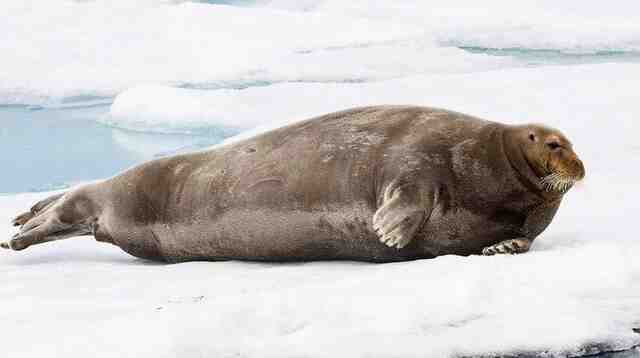Bearded seal
IUCN
LCBasic Information
Scientific classification
- name:Bearded seal
- Scientific Name:Bearded seal
- Outline:Carnivora
- Family:Pinnipeds Phocidae B.seals
Vital signs
- length:2-2.5m
- Weight:200-425kg
- lifetime:20-25years
Feature
The famous "Arctic Fat House"
Distribution and Habitat
They are distributed in sheets around the poles, generally in the area south of 85°N in the Arctic and subarctic.
Origin (sea): Canada, Greenland, Iceland, Japan, Norway, Russia, Svalbard, Jan Mayen Island, United States.
Roaming area (sea): China, Faroe Islands, France, Germany, Netherlands, Portugal, Spain, United Kingdom.
In China, they are distributed in Shanghai (Chongming Island) and Zhejiang (Ningbo, Pingyang).
They usually live on sea ice and live in shallow water areas with drifting ice, which often form open waterways and ice lakes. In some areas, bearded seals are known to go ashore and go up to streams; or stay away from drifting ice and land and live in the open ocean for a long time. Bearded seals are distributed in small sheets in the Arctic and subarctic, and are commonly seen in coastal waters. They like to live on drifting ice.
Appearance
They have a small head and relatively short front flippers, which make the body appear longer. The head is round and slightly narrow, with relatively small eyes set close together. The muzzle is broad and fleshy, with nostrils far apart. The vibrissae are numerous, long, dense, and light-colored, not bead-shaped like those of other Arctic seals. When wet, the vibrissae are straight, but when dry, the tips curl inward. The name "bearded seal" comes from this particularly prominent beard. The front flippers are short, relatively wide, and square or slightly rounded. The toes are equal in length or the third toe is slightly longer, and the claws are very strong. The bearded seal has four retractable nipples instead of two. This is what distinguishes it from all other Arctic seals.
Details
Bearded seal has two subspecies and is the seal with the longest beard in the ocean.

Bearded seals generally live alone and rarely board the same iceberg with other individuals. However, small groups of bearded seals can be seen on the ice in spring and early summer. Bearded seals that come onto the ice always face the water and are rarely more than one body length away from the water. Bearded seals are very vigilant. When they are on the ice, they will immediately flee into the sea water even if they feel a little danger. Males can make very loud roars. Most dives are less than 100m deep, and the maximum dive record of adults is close to 300m. The dive record of a few-month-old juvenile exceeds 488m.
Bearded seals mostly move in dispersed groups during migration, and generally do not gather in large groups. Only occasionally can large groups of about 1,000 be seen. In winter, they are generally active in cold waters, and in summer, they gather near estuaries where fish gather. They often move their habitats, and generally only stay in the same place for a few days or weeks, but do not migrate for long distances. In summer, they like to gather near estuaries. [3] Some populations remain in their locations year-round, while others migrate north in the summer with the retreating ice and return south in the late fall and winter with the advancing ice.
Many average-looking, fat people are potential “microphone masters”. Bearded seals are no exception, and they are so good at singing that in the summer, these “baritone singers” use elaborate songs to express love or establish their own territories. These songs, which are composed of several variations of trills, groans, and laments, can spread over a radius of 12 miles (nearly 20 kilometers) and last for 3 minutes.
The global population has not been quantified (Kovacs 2002). An estimated 200,000–250,000 individuals are present in the Sea of Okhotsk, of which 60,000–75,000 are east of Sakhalin Island (1968–1990). An estimated 250,000–300,000 individuals are present in the Bering Sea, of which 83,000–87,000 are present in the western Bering Sea (Fedoseev 2000). Based on 35 years of sampling data, at least 190,000 individuals are present in Canadian waters (Cleator 1996). Angliss and Outlaw (2005) believe that the current population data for the Bering and Chukchi Seas are unreliable. Population data for the Atlantic Ocean (from the Barents to the Chukchi Seas) are unknown (Reijnders et al. 1993).
Listed in the IUCN Red List of Threatened Species: Least Concern (LC), assessed in 2008.
Listed in China's National Key Protected Wildlife List: National Class II Protected Animal (effective December 10, 1988, all species of Pinnipeds*)
Listed in China's National Key Protected Wildlife List, Class II.
Protect wildlife and stop eating game.
Maintaining ecological balance is everyone's responsibility!








